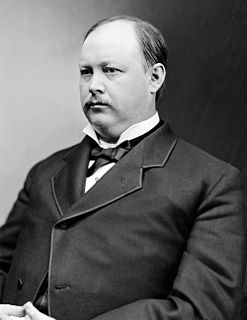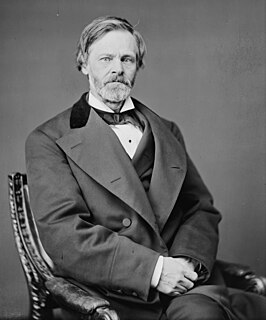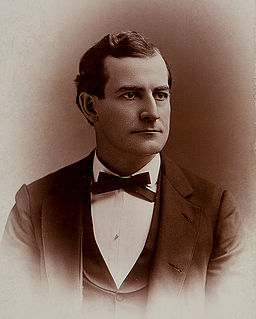
The United States presidential election of 1896 was the 28th quadrennial presidential election, held on Tuesday, November 3, 1896. Former Governor William McKinley, the Republican candidate, defeated Democrat William Jennings Bryan. The 1896 campaign, which took place during an economic depression known as the Panic of 1893, was a realigning election that ended the old Third Party System and began the Fourth Party System.

The Canadian federal election of 1896 was held on June 23, 1896, to elect members of the House of Commons of Canada of the 8th Parliament of Canada. Though the Conservative Party won a plurality of the popular vote, the Liberal Party, led by Wilfrid Laurier, won the majority of seats to form the next government.

The Canadian federal election of 1891 was held on March 5 to elect members of the House of Commons of Canada of the 7th Parliament of Canada. It was won by the Conservative Party of Prime Minister Sir John A. Macdonald.

Elections to the United States House of Representatives were held in 1896 for members of the 55th Congress, coinciding with the election of President William McKinley.

The Fifty-fourth United States Congress was a meeting of the legislative branch of the United States federal government, consisting of the United States Senate and the United States House of Representatives. It met in Washington, D.C. from March 4, 1895, to March 4, 1897, during the last two years of Grover Cleveland's presidency. The apportionment of seats in the House of Representatives was based on the Eleventh Census of the United States in 1890. The House had a Republican majority, and the Republicans were the largest party in the Senate.

The New Zealand general election of 1896 was held on Wednesday, 4 December in the general electorates, and on Thursday, 19 December in the Māori electorates to elect a total of 74 MPs to the 13th session of the New Zealand Parliament. A total number of 337,024 (76.1%) voters turned out to vote.

The United States House of Representatives elections in California, 1896 was an election for California's delegation to the United States House of Representatives, which occurred as part of the general election of the House of Representatives on November 3, 1896. Republicans lost one seat to the Democrats and two to the Populists.

The 1897 South Carolina United States Senate election was a unanimous election of the Democratic nominee on January 26, 1897 to select the U.S. Senator from the state of South Carolina. The Democratic primary election was held on August 26, 1896 and September 9. Prior to the ratification of the 17th Amendment to the United States Constitution, U.S. Senators were elected by the state legislature and not through the direct election by the people of the state. However, the Democratic Party of South Carolina organized primary elections for the U.S. Senate beginning in 1896 and the General Assembly would confirm the choice of the Democratic voters. Conservative Democratic Joseph H. Earle won the Democratic primary and was elected by the General Assembly for a six-year term.

The 1896 United States presidential election in California refers to how California participated in the 1896 United States presidential election. California narrowly voted for the Republican nominee, Ohio Governor William McKinley, over the Democratic nominee, former Nebraska representative William Jennings Bryan. One elector cast a vote for Bryan.

The United States Senate elections of 1896 and 1897 were elections in which the Democratic Party lost seven seats in the United States Senate, mostly to smaller third parties.

The 1896 United States presidential election in Pennsylvania took place on November 3, 1896. Voters chose 32 representatives, or electors to the Electoral College, who voted for president and vice president.

The 1900 United States presidential election in New York took place on November 6, 1900. All contemporary 45 states were part of the 1900 United States presidential election. New York voters chose 36 electors to the Electoral College, which selected the president and vice president.

The 1896 United States presidential election in New York took place on November 3, 1896. All contemporary 45 states were part of the 1896 United States presidential election. New York voters chose 36 electors to the Electoral College, which selected the president and vice president.

The 1896 United States elections elected the 55th United States Congress. Republicans won control of the Presidency and maintained control of both houses of Congress. The election marked the end of the Third Party System and the start of the Fourth Party System, as Republicans would generally dominate politics until the 1930 elections. Political scientists such as V.O. Key, Jr. argue that this election was a realigning election, while James Reichley argues against this idea on the basis that the Republican victory in this election merely continued the party's post-Civil War dominance. The election took place in the aftermath of the Panic of 1893, and featured a fierce debate between advocates of bimetallism and supporters of the gold standard.

The 1896 United States presidential election in Virginia took place on November 3, 1896, as part of the 1896 United States presidential election. Voters chose twelve representatives, or electors to the Electoral College, who voted for president and vice president.
Elections to Liverpool City Council were held on Monday 2 November 1896. One third of the council seats were up for election, the term of office of each councillor being three years.
Elections to Liverpool City Council were held on Thursday 1 November 1895. This was an 'all up' election following boundary changes which extended the area of the city and increased the number of wards from 16 to 28. Three councillors were elected for each ward. The candidate with the most votes was elected for three years, the candidate with the second highest number of votes was elected for two years and the candidate with the tthird highest number of votes was elected for one year.

The 1896 United States presidential election in Vermont took place on November 3, 1896. Voters chose four representatives, or electors to the Electoral College, who voted for president and vice president.

The 1896 United States presidential election in Massachusetts took place on November 3, 1896 as part of the 1896 United States presidential election. Voters chose 15 representatives, or electors to the Electoral College, who voted for president and vice president.












